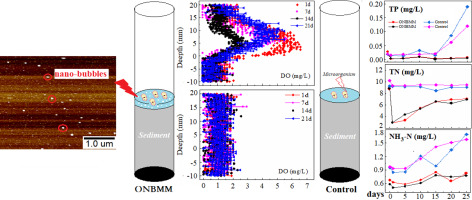当前位置:
X-MOL 学术
›
Sci. Total Environ.
›
论文详情
Our official English website, www.x-mol.net, welcomes your feedback! (Note: you will need to create a separate account there.)
Oxygenation and synchronous control of nitrogen and phosphorus release at the sediment-water interface using oxygen nano-bubble modified material.
Science of the Total Environment ( IF 9.8 ) Pub Date : 2020-03-27 , DOI: 10.1016/j.scitotenv.2020.138258 Jingfu Wang 1 , Jingan Chen 1 , Pingping Yu 2 , Xiaohong Yang 2 , Lijuan Zhang 3 , Zhanli Geng 4 , Kangkang He 2
Science of the Total Environment ( IF 9.8 ) Pub Date : 2020-03-27 , DOI: 10.1016/j.scitotenv.2020.138258 Jingfu Wang 1 , Jingan Chen 1 , Pingping Yu 2 , Xiaohong Yang 2 , Lijuan Zhang 3 , Zhanli Geng 4 , Kangkang He 2
Affiliation

|
Synchronously controlling the nitrogen (N) and phosphorus (P) release from sediments is an important basis for eutrophication management in lakes, but it is still a technical challenge at present. Loading nano-bubbles on the surface of natural minerals to increase dissolved oxygen(DO) level at the sediment-water interface (SWI)provides a possible solution to this problem. In this study, oxygen nano-bubble modified mineral (ONBMM) technology was developed, and its efficiency of oxygenation at the SWI and effect on the removal of internal nutrient input were evaluated under simulated conditions. The results showed that ONBMM effectively improved DO levels near the SWI; the highest concentration reached 6.55 mgL-1. Meanwhile, adding ONBMM remarkably reduced the concentrations of total P(TP), total N(TN) and ammonia N(NH3-N) in the overlying water. Compared with the control group, the fluxes of TP, NH3-N, and TN loading from sediments in simulation cores treated with ONBMM reduced by 96.4%, 51.1%, and 24.9%, respectively. The high-resolution data obtained by DGT showed that ONBMM effectively inhibited the reduction and release of FeP through increasing the oxygen level at the SWI. The results of 16S rRNA high-throughput sequencing showed that adding ONBMM strengthened the role of nitrobacteria, denitrifying bacteria, and ammonia oxidation bacteria at the SWI. The ONBMM technology provides a new tool to achieve oxygenation at the SWI and in situ control of internal pollution in eutrophic lakes.
中文翻译:

使用氧纳米气泡改性材料对沉积物-水界面的氧和氮和磷的释放进行同步控制。
同步控制沉积物中氮(N)和磷(P)的释放是湖泊富营养化管理的重要基础,但目前仍是一项技术挑战。在天然矿物表面上装载纳米气泡以增加沉积物-水界面(SWI)的溶解氧(DO)水平,为解决这一问题提供了可能的解决方案。在这项研究中,开发了氧纳米气泡改性矿物(ONBMM)技术,并在模拟条件下评估了其在SWI处的氧化效率以及对去除内部养分输入的影响。结果表明,ONBMM有效地提高了SWI附近的溶解氧水平。最高浓度达到6.55 mgL-1。同时,添加ONBMM显着降低了上覆水中总P(TP),总N(TN)和氨氮(NH3-N)的浓度。与对照组相比,用ONBMM处理的模拟岩心中沉积物的TP,NH3-N和TN负荷通量分别降低了96.4%,51.1%和24.9%。DGT获得的高分辨率数据表明,ONBMM通过增加SWI处的氧气水平有效地抑制了FeP的还原和释放。16S rRNA高通量测序的结果表明,添加ONBMM可以增强SWI上的硝化细菌,反硝化细菌和氨氧化细菌的作用。ONBMM技术提供了一种新的工具,可以在SWI处实现充氧,并就地控制富营养化湖泊的内部污染。DGT获得的高分辨率数据表明,ONBMM通过增加SWI处的氧含量有效地抑制了FeP的还原和释放。16S rRNA高通量测序的结果表明,添加ONBMM可以增强SWI上的硝化细菌,反硝化细菌和氨氧化细菌的作用。ONBMM技术提供了一种新的工具,可以在SWI处实现充氧,并就地控制富营养化湖泊的内部污染。DGT获得的高分辨率数据表明,ONBMM通过增加SWI处的氧气水平有效地抑制了FeP的还原和释放。16S rRNA高通量测序的结果表明,添加ONBMM可以增强SWI上的硝化细菌,反硝化细菌和氨氧化细菌的作用。ONBMM技术提供了一种新的工具,可以在SWI处实现充氧,并就地控制富营养化湖泊的内部污染。
更新日期:2020-03-27
中文翻译:

使用氧纳米气泡改性材料对沉积物-水界面的氧和氮和磷的释放进行同步控制。
同步控制沉积物中氮(N)和磷(P)的释放是湖泊富营养化管理的重要基础,但目前仍是一项技术挑战。在天然矿物表面上装载纳米气泡以增加沉积物-水界面(SWI)的溶解氧(DO)水平,为解决这一问题提供了可能的解决方案。在这项研究中,开发了氧纳米气泡改性矿物(ONBMM)技术,并在模拟条件下评估了其在SWI处的氧化效率以及对去除内部养分输入的影响。结果表明,ONBMM有效地提高了SWI附近的溶解氧水平。最高浓度达到6.55 mgL-1。同时,添加ONBMM显着降低了上覆水中总P(TP),总N(TN)和氨氮(NH3-N)的浓度。与对照组相比,用ONBMM处理的模拟岩心中沉积物的TP,NH3-N和TN负荷通量分别降低了96.4%,51.1%和24.9%。DGT获得的高分辨率数据表明,ONBMM通过增加SWI处的氧气水平有效地抑制了FeP的还原和释放。16S rRNA高通量测序的结果表明,添加ONBMM可以增强SWI上的硝化细菌,反硝化细菌和氨氧化细菌的作用。ONBMM技术提供了一种新的工具,可以在SWI处实现充氧,并就地控制富营养化湖泊的内部污染。DGT获得的高分辨率数据表明,ONBMM通过增加SWI处的氧含量有效地抑制了FeP的还原和释放。16S rRNA高通量测序的结果表明,添加ONBMM可以增强SWI上的硝化细菌,反硝化细菌和氨氧化细菌的作用。ONBMM技术提供了一种新的工具,可以在SWI处实现充氧,并就地控制富营养化湖泊的内部污染。DGT获得的高分辨率数据表明,ONBMM通过增加SWI处的氧气水平有效地抑制了FeP的还原和释放。16S rRNA高通量测序的结果表明,添加ONBMM可以增强SWI上的硝化细菌,反硝化细菌和氨氧化细菌的作用。ONBMM技术提供了一种新的工具,可以在SWI处实现充氧,并就地控制富营养化湖泊的内部污染。



























 京公网安备 11010802027423号
京公网安备 11010802027423号